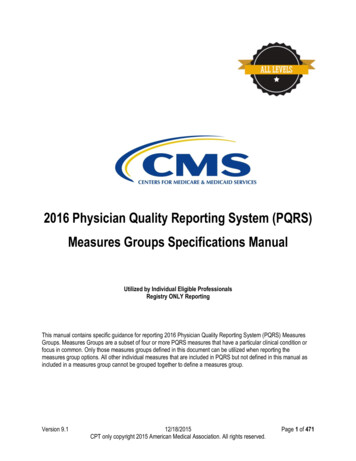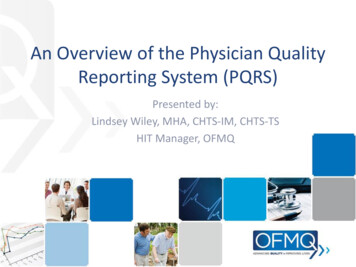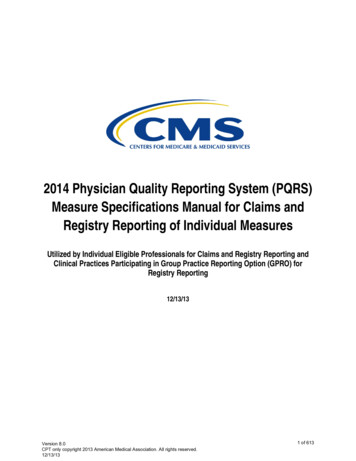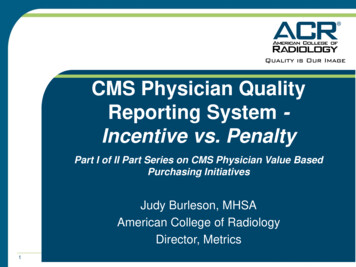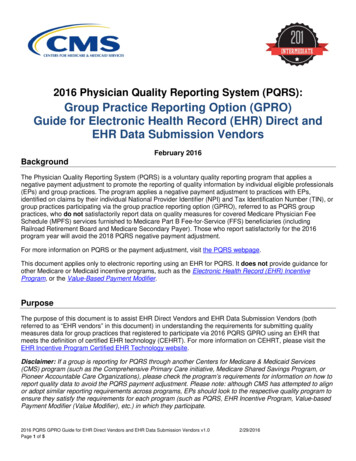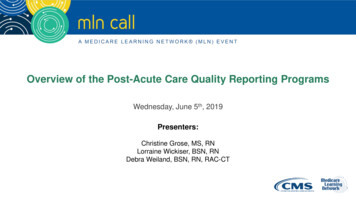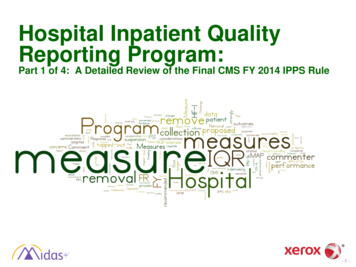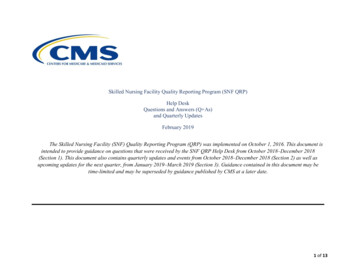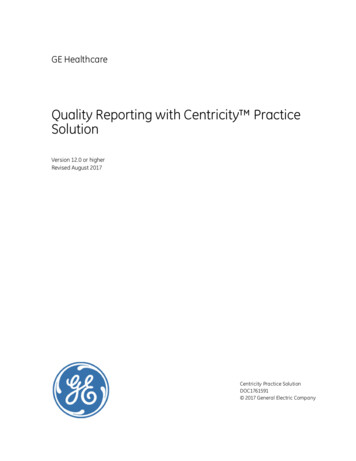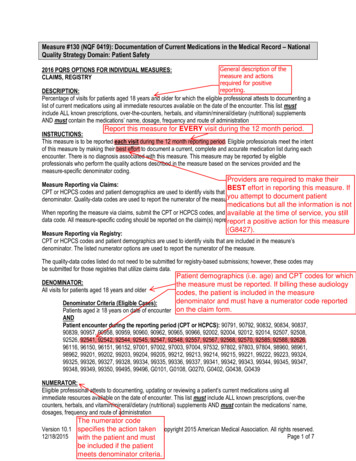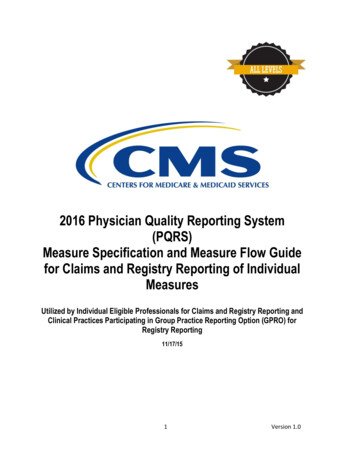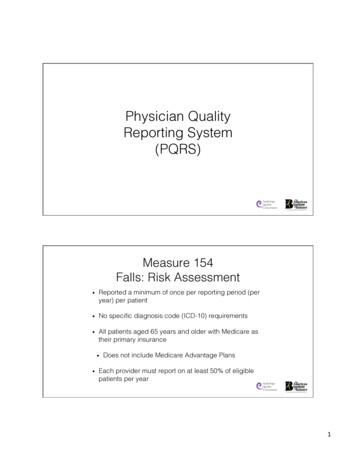
Transcription
Physician QualityReporting System !(PQRS)!Measure 154 !Falls: Risk Assessment! Reported a minimum of once per reporting period (peryear) per patient! No specific diagnosis code (ICD-10) requirements! All patients aged 65 years and older with Medicare astheir primary insurance! Does not include Medicare Advantage Plans!Each provider must report on at least 50% of eligiblepatients per year!1
CPT Codes! Measure #154 must be reported when billing thefollowing CPT codes that are relevant to audiology:! 92540: Basic Vestibular Evaluation (which includes92541, 92542, 92544, & 92545)! 92541: Spontaneous nystagmus (with recording)! 92542: Positional nystagmus (4 positions withrecording)! 92548: Computerized Dynamic Posturography!Important CMS Definitions! Fall: A sudden, unintentional change in positioncausing an individual to land at a lower level, onan object, the floor, or the ground, other than aconsequence of sudden onset of paralysis,epileptic seizure, or overwhelming external force! Injury: Requiring medical attention!2
Fall Risk Assessment!Comprised of balance/gait evaluation:! including documentation of observed transfer and walking ! OR use of a standardized scale (e.g., Timed Up and Go,CTSIB, Functional Reach, Berg, Tinetti) ! OR documentation of referral for assessment of balance/gait!Fall Risk Assessment!AND one or more of the following:! Postural blood pressure: Documentation of blood pressurevalues in supine and then standing positions! Vision Assessment: Documentation that the patient is or is notfunctioning well with vision based on discussion with the patientOR documentation of referral for vision assessment! Home fall hazards: Documentation of counseling on home fallshazards OR referral for evaluation of home falls hazards! Documentation on whether medications are contributory or notto falls within past 12 months!3
Measure 154!CPT II Codes! 1101F: Patient is not eligible for this measurebecause no falls or only one fall without injury haveoccurred within the past 12 months! If this is reported, no further CPT II Codes arenecessary to report for measures 154 or 155!Measure 154!CPT II Codes! 1100F: Two or more falls are documented within thepast 12 months OR any fall with injury within thepast 12 months! 1100F-1P: Documentation of medical reason(s) fornot completing fall risk assessment! Patient is non-ambulatory, bed ridden, immobile,wheelchair bound!1100F-8P: No documentation of falls status!4
Measure 154!CPT II Codes! 3288F: Fall Risk Assessment documented! 3288F-1P: Fall Risk Assessment unable to assessdue to limited mobility/non-ambulatory status! 3288F-8P: Falls Risk Assessment not completed,reason otherwise unspecified! Performance not met; Negative reporting!Measure 154!CPT II Codes! When reporting for Measure 154, if the patient hasfallen twice in the past year or any fall has hadinjury, you will need to report 2 CPT II codes! Example: Patient has fallen twice in the past yearand a Falls Risk screening is performed anddocumented on the same day as VNG testing.CPT II Codes reported should include 1100F and3288F.!5
Measure 155!Falls: Plan of Care! Second part of the 2-part measure paired with Measure#154! Reported if Measure #154 includes CPT II Code 1100F:Patient screened for future falls risk; documentation of twoor more falls in the past year or any fall with injury in the pastyear! Same reporting criteria as Measure #154! Rationale: Interventions to prevent future falls should bedocumented for the patient with 2 or more falls or injuriousfalls!Important CMS Definitions! Plan of Care: Must include BOTH of the following:!1. Vitamin D supplementation! Patient referred to his/her physician for vitamin D supplementationadvice OR! Documentation that supplementation was advised or considered!2. Balance, strength, and gait training! Instructions provided OR! Recommendation/referral for exercise program OR! Recommendation/referral for Physical Therapy!6
Measure 155!CPT II Codes! 0518F: Falls Plan of Care Documented! 0518F-1P: Medical Reason for no plan of caredocumented!Patient is non-ambulatory, bed ridden, immobile,wheelchair bound! 0518F-8P: Plan of care not documented; reason nototherwise specified!Performance not met; Negative reporting! Balance Screening Protocols! Timed Up and Go (TUG)! Functional Reach Test (FRT)! Clinical Test of Sensory Integration of Balance (mCTSIB)!7
Timed Up and Go(TUG)!Timed Up and Go (TUG)!8
Timed Up and Go (TUG)! Purpose: Assesses mobility, balance, walkingability, and fall risk in older adults! Equipment needed: Standard armchair and a stopwatch! Length of time: 5 minutes or less!TUG: How to Perform! The patient sits in a chair with his/her back against the chair back! On the practitioner’s command, the patient rises from the chair, walks 3 meters(about 10 feet) at a comfortable and safe pace, turns, walks back to the chair,and sits down! The timer starts when the patient begins to rise from the chair, and the timerstops when the patient sits down! Three trials should be completed; the first trial is considered practice and notscored. Use the best score of the second and third trials! Patient should wear their regular footwear and use their assistive device, if theyhave one! For patients with acute onset vestibulopathy, to ensure test reliability, it shouldbe administered with both a right and left turn!9
TUG: Scoring! An older adult who takes 12 seconds or more tocomplete the task is at a high risk of falling! Sensitivity and Specificity are 87%! Strong correlation with functional mobility! The longer the patient takes to perform the taskhas a direct correlation with dependence inActivities of Daily Living (ADLs)!Functional Reach Test!10
Functional Reach Test (FRT)!Functional Reach Test (FRT)! Purpose: Assesses a patient’s stability bymeasuring the maximum distance an individual canreach forward while standing in a fixed position! Equipment Needed: Yardstick attached to wall in ahorizontal position! Length of Time: 5 minutes or less!11
FRT: How to Perform! Patient is instructed to stand close to a wall without touching it! The arm closest to the wall is positioned at 90 degrees ofshoulder flexion with a closed fist! Record the starting position at the knuckle of middle finger (3rdmetacarpal head) on the yardstick! Instruct the patient to “reach as far as you can forward withouttaking a step”! Watch that the patient does not lift their heels off the ground! Record the position of the knuckle on the yardstick!FRT: Scoring! The score is the difference between the start and endposition of the knuckle is the reach distance, usuallymeasured in inches! Patient may need one or two trial runs that are not scored! The average of three runs is the final score in inches! FRT score of greater than 10 inches is considered normal! FRT score of less than 6 inches is considered high riskfor falls!12
Modified Clinical Test ofSensory Integration ofBalance (mCTSIB)!mCTSIB!13
Modified CTSIB (mCTSIB)! Purpose: Assess the patient’s balance undervarious sensory conditions! Equipment Needed: Standardized foam! Length of Time: Less than 10 minutes!mCTSIB: How to Perform! For all Conditions: The patient is standing with their feet comfortably apart (aboutshoulder width) and their arms at their sides! Condition 1: Patient stands on a firm surface with their eyes open! Condition 2: Patient stands on a firm surface with their eyes closed! Sensory information: vestibular and somatosensory!Condition 3: Patient stands on an unstable surface (foam) with eyes open! Sensory information: all three sensory inputs: visual, vestibular, and somatosensory!Sensory information: vision and vestibular!Condition 4: Patient stands on an unstable surface (foam) with eyes closed! Sensory information: vestibular !14
mCTSIB: Scoring! Condition 1 is considered a baseline! Condition 2: inability to perform or significant swayindicates a visual dependence ! Condition 3: inability to perform or significant swayindicates somatosensory dependent! Condition 4: inability to perform or significant swayindicates vestibular disruption likely (with 90% sensitivity)! If the patient moves their arms (Parachute Reflex) or theirfeet, this is considered a Fall on that condition!Summary! Audiologists have an excellent opportunity andresponsibility to become important stakeholders in Fall Riskand Fall Management of older adults.! This role may be accomplished through patient education,referrals and triage or actual balance screenings.! With 10,000 baby boomers turning 65 years old each dayfor the next 18 years, there will be a growing populationrequiring the audiologist’s expertise and care.!15
Instructors!Richard E. Gans, Ph.D.Sara Jagger, Au.D.AdvisorsJim Eimer, PTMargaret Loughran, ARNP- C (Geriatrics)Lynn Sumerson, D.O. (ENT Physician)Research AssistantsDhruva Kumbhani, B.S. (Au.D. Candidate)Taylor Unger, B.S., ( Au.D. Candidate)References!1. Agrawal, Y., Carey, J.P, Della Santina, C.C., Schubert, M.C., & Minor, L.B. (2009). Disorders ofbalance and vestibular function in US adults: data from the National Health and NutritionExamination Survey, 2001-2004. Archives of Internal Medicine, 169(10), 938-44.!2. Boogle Thorbahn, L.D. & Newton, R.A. (1996). Use of the Berg Balance Test to predict falls inelderly persons. Physical Therapy, 76(6), 576-83.!3. Cohen, H., Blatchly, C.A., & Gombash, L.L. (1993). A study of the clinical test of sensoryinteraction and balance. Physical Therapy, 73(6), 346-51.!4. Downs, S., Marguez, J., & Chiarelli, P. (2014). Normative scores on the Berg Balance Scaledecline after age 70 years in healthy community-dwelling people: a systematic review. Journal ofPhysiotherapy, 60(2), 85-9.!16
5. Duncan, P.W., Weiner, D. K., Chandler, J., & Studenski, S. (1990). Functional reach: A newclinical measure of balance. Journal of Gerontology, 45(6), M192-197.!6. Gans, R.E. (2011). Dizziness, Vertigo, and falls: issues for older adults and practitioners. ENT& Audiology News, 20(1).!7. Gunn, H., Markevics, S., Haas, B., Marsden, J., & Freeman, J. (2015). Systematic review: Theeffectiveness of interventions to reduce falls and improve balance in adults with multiplesclerosis. Archives of Physical Medicine and Rehabilitation, 96(10), 1898-912.!8. Hayes, K.W., & Johnson, M.E. (2003). Measures of adult general performance tests. The BergBalance Scale, Dynamic Gait Index (DGI), gait velocity, Physical Performance Test (PTT), TimedChair Stand Test, Timed Up and Go, and Tinetti Performance-Oriented Mobility Assessment(POMA). Arthritis & Rheumatism, 45(S5), S28-42. !9. Lesinski, M., Hortobagyi, T., Muehlbauer, T., Gollhofer, A., & Granacher, U. (2015). Effects ofbalance training on balance performance in healthy older adults: A systematic review and metaanalysis. Sports Medicine, 45(12), 1721-38.!!!10. Perell, K.L, Nelson, A., Goldman, R.L., Luther, S.L., Prieto-Lewis, N., & Rubenstein, L.Z.(2001). Fall risk assessment measures: an analytic review. The Journals of Gerontology. Series A,Biological Sciences and Medical Sciences, 56(12), M761-6.!11. Sibley, K.M., Howe, T., Lamb, S.E., Lord, S.R., Maki, B.E., Rose, D.J, Jaglal, S.B. (2015).Recommendations for a core outcome set for measuring standing balance in adult populations: aconsensus-based approach. PLoS One, 10(3).!12. Shumway-Cook, A., & Horak, F.B. (1986). Assessing the influence of sensory interaction onbalance. Suggestion from the field. Physical Therapy, 66(10), 1548-50.!13. Steffen, T.M., Hacker, T.A., & Mollinger, L. (2002). Age- and gender-related test performancein community-dwelling elderly people: Six-minute Walk Test, Berg Balance Scale, Timed Up & GoTest, and gait speeds. Physical Therapy, 82(2), 128-37.!14. Whitney, S.L., Poole, J.L., Cass, S.P. (1998). A review of balance instruments for older adults.The American Journal of Occupational Therapy, 52(8), 666-71.!!17
3 Fall Risk Assessment! Comprised of balance/gait evaluation:! including documentation of observed transfer and walking ! OR use of a standardized scale (e.g., Timed Up and Go, CTSIB, Functional Reach, Berg, Tinetti) ! OR documentation of referral for assessment of balance/ gait!
